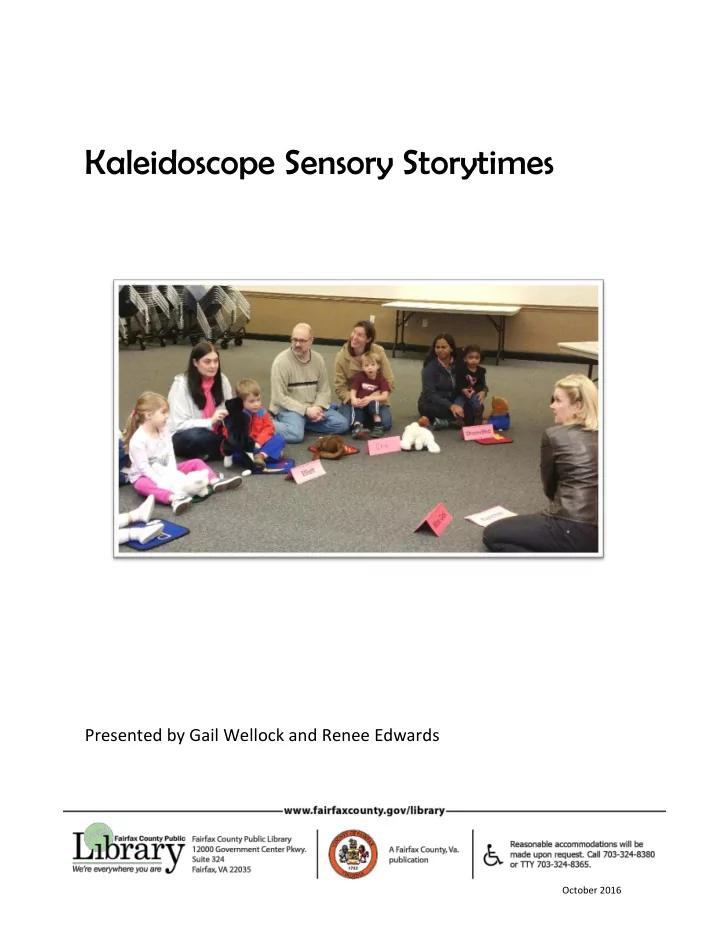

Kaleidoscope Sensory Storytimes Presented by Gail Wellock and Renee Edwards October 2016
Kaleidoscope Sensory Storytimes Objectives: Understand the importance creating an environment that is welcoming to children with special needs. Learn the types of books and songs/chants that work well with these children. Discover effective strategies when planning and presenting sensory storytimes. Why are Sensory Storytimes Important? Sensory Storytimes: Let families know they are welcome in the library! Teach special kids how to interact with librarians and books. Help special kids transition to regular library programs. Provide a safe space for children who may be too loud or impulsive to participate in other library activities. Provide a place for families to meet and network. Support the five early literacy practices: playing, reading, writing, singing and talking. Provide social opportunities for children and parents. Creating the Proper Environment Children need to feel protected, secure and valued. Room set-up and presentational elements invite engagement, focus, routine, safety and comfort. Play low-key/acoustic – gentle music. Make sure lights are dimmed. Have carpet tiles for each child – helps them focus and delineates personal space. Keep room empty of clutter and distractions. o Keep toys, books and puzzles covered or hidden. o Hide supplies in a basket or under a bench. o Keep table tops clear. Close door when storytime begins. Have a visual schedule board so everyone can follow along. Set up the room the same way each time. Include a half-hour of playtime and socialization at the end. Use books, rhymes, songs and movement activities that are interactive (shared experience). Be extremely flexible – fully aware of all activities in the room – change the program based on the children’s needs (switch books, take down visual card, sing, movement activity, end storytime). Create a safe and non-judgmental environment - maintain expectations with an even tone and reinforce positive behaviors with praise and patience. 2017 Page 2
Kaleidoscope Sensory Storytimes Books That Work Well Almost any book will work for sensory storytimes, but these books work the best: Read Sing, Read to a Beat Repeating Phrases Rhyming Felt Stories Big Books Board Books Selecting Picture Books Ask yourself: Is the book based on children’s experiences and interests? Does the book have repetition? Are the illustrations large and uncluttered? Is the book adaptable? Using Board Book Sets Why use them? Each family has a book that everyone can read and/or sing together. Emphasizes print awareness. Children see that print has meaning and how we use books. Encourages adults to have a meaningful share in the storytime. Want a successful read aloud? Have a plan and adapt. Remember the child is at the center. The following suggestions may help: Make eye contact – children love being seen. Read with expression. Involve children and caregivers in the read aloud – read with them, not at them. Adapt, be flexible and allow the program to emerge from the children’s needs/wants. Repetition is key. It is okay to read same book at every program. Share 3-4 books – two are the same every storytime. Singing Songs and Chanting Rhymes Strategies for singing and chanting success: Repetition is key – sing/chant 2-3 times. Sing softly, slowly, in a non-frenetic pace with fluid movements. Use songs and chants you like and use again and again. 2017 Page 3
Kaleidoscope Sensory Storytimes Change up your favorite or traditional songs or rhymes. (Add a twist to words or movement.) Include more songs than a regular storytime. Make songs tactile through scarves, ribbons, beanbags, parachutes, egg shakers or any other prop. Strategies for Success Four Ss Say less – Use simple words for more complex words or phrases. Stress – Stress important words by using tone of voice and inflection as you read. Slow – Speak slowly so you can make sure that the children can following. Special kids may take longer to process information. Show – Point to the pictures as you read so the children will know who or what is read about. Emotional Connection – Reflect Love Place children in the light – see and recognize the light and potential within each child. When children experience their light reflected back to them, they flower. Continually honor the light or seed potential in each child – just as the gardener plants a seed with a vision of the flower in mind. Remember the Three Rs Routine – Children feel safe and at ease when they know what to expect. Repetition – This gives children a chance to become familiar and more successful learning and interacting with the songs and finger plays. Redundancy – This gives children several ways to understand the story, song or directions . Create Storytime Expectations for Everyone What can you say? Welcome everyone. Discuss what will occur in storytime (point out visual schedule). Tell them what to do if their children cries and needs a moment to calm down. Ask adults to participate in storytimes. Stay positive. Why is this important? Parents and caregivers know what to expect and everyone feels comfortable. 2017 Page 4
Recommend
More recommend